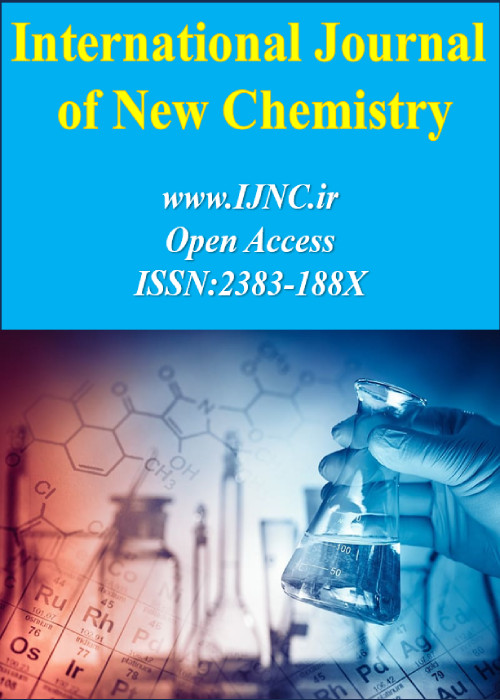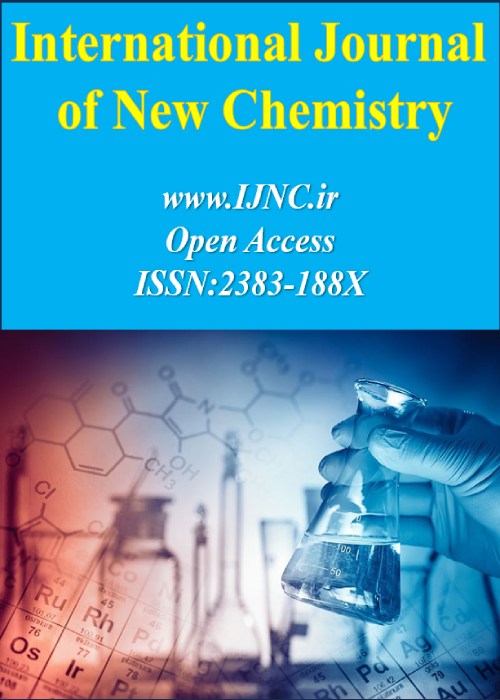فهرست مطالب

International Journal of new Chemistry
Volume:11 Issue: 2, Summer 2024
- تاریخ انتشار: 1402/10/20
- تعداد عناوین: 6
-
Pages 82-89
Acrylamide is a toxic chemical that is formed in starchy foods like potato chips and can cause cancer in humans. Therefore, its detection is of great importance. In this research, the performance of C24 fullerene as an electrocatalytic sensing material for acrylamide was checked out by DFT simulations. The obtained adsorption energies showed acrylamide interaction with C24 is experimentally feasible. The calculated thermodynamic parameters including ΔGad, ΔHad, and Kth showed acrylamide adsorption process is spontaneous, exothermic, and reversible. The NBO results demonstrated no chemical bond has created between acrylamide and fullerene in the adsorption procedure, hence the adsorption nature is a physisorption. The calculated frontier molecular orbital indices showed the bandgap of fullerene experienced a -52% decline after interacting with acrylamide. Therefore, this nanostructure can be employed as an excellent electrocatalytic sensing material for the fabrication of a new electrochemical sensor for the determination of acrylamide.
Keywords: Acrylamide, density functional theory, Adsorption, Fullerene (C24), sensor -
Pages 90-112The rapid growth of the plastic/polymer industry and the increasing amount of plastic waste has generated a need for the development of more sustainable alternatives to the production and use of polymer products. Green chemistry provides numerous benefits for the polymer manufacturing process, including energy savings, a smaller ecological footprint, and enhanced product performance. Energy can be saved by reducing the number of steps in the manufacturing process and replacing traditional energy-intensive processes, such as thermal polymerization, with more efficient alternatives when using green chemistry. Green chemistry offers an innovative approach to the production of polymer products through the use of environmentally friendly and sustainable chemical processes. This paper explores the application of green chemistry to the manufacturing of plastic/polymer products, focusing on the production of biodegradable polymers with emphasizes on the advantages of green chemistry principles on plastic productions. Also entailed in this study are some perceived problems associated with functional polymers and plastics.Keywords: Green Chemistry, Polymer, plastic, Biodegradable
-
Pages 113-122Using a molecularly imprinted polymer (MIP) as a recognition element, a selective voltammetric sensor for ketoconazole (KC) was designed and constructed. MIP was synthesized using methacrylic acid as a functional monomer and KC as a template, and then into the carbon paste electrode as a ketoconazole sensor, was incorporated. A new chemically modified electrode containing MIP compound on the surface of a glassy carbon electrode (GCE) by sol-gel method was obtained. The electrochemical behavior of the resulting modified electrode by cyclic voltammetry method in detail was investigated. The obtained film electrode had very good stability and thus exhibited a good electrocatalytic response for KC oxidation. A sharp catalytic oxidation peak was observed at around 53 mV in the MIP/CCE electrode and GCE, and a small oxidation peaks current at about 63 mV was observed. The diffusion coefficient and transfer coefficient (α) for the electrocatalytic oxidation of KC were also studied under experimental conditions.Keywords: Carbon Ceramic Electrode (CCE), Cyclic voltammetry, Ketoconazole (KC), Molecularly Imprinted Polymer (MIP)
-
Pages 123-132In recent decades, herbal therapies derived from plants have become increasingly popular, particularly in disadvantaged countries with limited access to western medical care. Due to their lower adverse effect risk, less cost, and greater accessibility, herbal medications are gaining appeal globally, especially in economically poor developing nations. After being harvested and transformed into herbal medicines, heavy metals in medicinal and aromatic plants are absorbed by individuals and accumulate in various organs. Toxic heavy metals may affect the heart, lungs, liver, and brain, which can be fatal. Because of this, it is necessary to limit hazardous heavy metals in herbal medicinal supplies. Six herbs Adhatoda vasica, Bacopa monnieri, Ocimum sanctum, Emblica officinalis, Terminalia arjuna, and Glycyrrhiza glabra were tested for their levels of nickel, chromium, mercury, cadmium, lead, and arsenic. As a consequence of our research, we found that the content Ni, Pb, Cr, As, Cd and Hg in Adhatoda vasica, Bacopa monnieri, Ocimum sanctum, Emblica officinalis, Terminalia arjuna, and Glycyrrhiza glabra is lower than what is allowed by the World Health Organization and the Food and Agriculture Organization.Keywords: Medicinal plants, heavy metals, Human Impacts
-
Pages 133-155The expanding use of cassava and its derivatives across industries in Nigeria has raised concerns about potential hydrogen cyanide (HCN) toxicity in inadequately processed cassava products. This study aimed to investigate and compare the hydrogen cyanide concentration in eight processed cassava product samples sourced from January to March 2023 from supermarkets and local markets in Lafia town, Nigeria, using the picrate in solution method. The samples included Niji® Foods Cassava Flour, IFGREEN® Odourless Fufu Flour, Ayoola® Fufu Flour, Aiteefills® Fufu flour, Niji® Foods Garri, Golden Penny Garri, GGEE® foods Ijebu Garri, and local brand cassava starch. Spectrophotometric measurements at 535 nm were used to determine the total cyanide content in mg HCN equivalents/kg dry weight, calculated as ppm by multiplying the absorbance by 396. The results were analysed using Minitab version 20.0, employing one-way ANOVA, and pair-wise comparisons were made post hoc using Tukey t-tests. HCN concentrations in all samples ranged from 4.13 to 21.47 mg HCN equivalents/kg dry weight, exhibiting significant variation (p ≤ 0.05) among the samples. Except for Niji® Foods Garri and Ayoola® Fufu Flour, all samples surpassed the benchmark limit set by FAO/WHO and SON (10 mg HCN/kg body weight). However, all samples were deemed safe for consumption as the hydrogen cyanide concentration did not exceed the lethal dose threshold (50 - 100 mg HCN/kg body weight). This study provides valuable insights into the hydrogen cyanide content of various processed cassava products and confirms their safety for consumption when adequately processed.Keywords: Cassava, hydrogen cyanide concentration, processed, Safety
-
Pages 156-203HO enzyme catalyzes the degradation of free heme to biliverdin, CO, and Fe in three consecutive steps. The up-regulated activity of heme oxygenase is thought to be correlated with the antioxidant role of HO-1 in an oxidative stress environment. HO enzyme regiospecificity oxidizes heme at α meso position in a three oxygenation steps process. Although hydroperoxy-ferric heme, generated in the first step, has been indicated as an intermediate in most heme enzyme, heme degradation is only occurred in HO reaction. Therefore, a different mechanism from the other heme enzymes must be responsible for the heme hydroxylation in HO-catalyzed reaction in the first step. In the second step of the process, there are also uncertainties regarding electron requirement and a binding site for O2 molecule. In this article, we review researchers’ attempts to elucidate complicated heme catabolism mechanism, especially in the less known process steps which have been done to shed light on the determinants of specificity and better contribute to developing new medicines. Special focus is placed on the experimental and theoretical studies on the structural characteristics and electronic configurations of heme catabolism intermediates catalyzed by HO. The fascinating electronic communication between the metal and the ring in this process has been discussed, as well. An overview of the non- precedent route for the direct conversion of oxophlorin to biliverdin is also presented.Keywords: Verdoheme, Biliverdin, DFT, QM, MM


